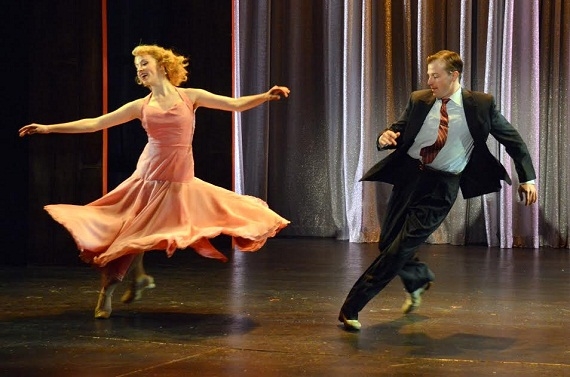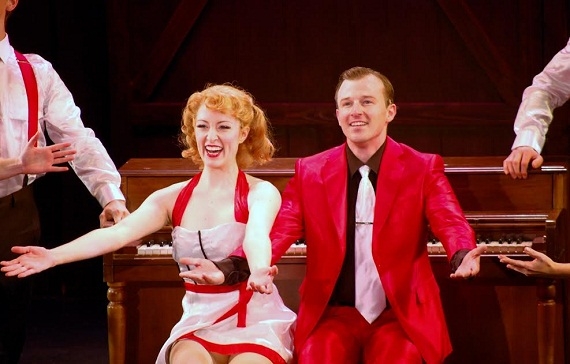Drew Humphrey Makes John W. Engeman Theater’s Christmas Extra Special
With ten years of joyous involvement, the choreographer and star of ”Irving Berlin’s White Christmas” discusses his pride for the holiday staple.
Irving Berlin's White Christmas is a timeless classic, which means it is at least somewhat familiar to most everyone lucky enough to catch it on stage. However, in its current incarnation at the John W. Engeman Theater at Northport, the beautifully festive piece has been given new life through delightful dance routines that are lengthy, complex, and packed with emotion. Drew Humphrey has been working in various presentations of the show (including both Broadway runs) for almost ten years, thus allowing him to lend his extensive understanding of the music and tone of the piece to his first crack at choreographing the holiday staple. In addition to creating the steps, Humphrey is starring as Phil Davis, a successful vaudeville star and veteran who is also known to be something of a ladies’ man. The Columbus, Ohio, native spoke with TheaterMania about his first time wearing the large hats of choreographer and lead performer in John W. Engeman Theater’s latest Broadway-caliber production.

(© Alan Pearlman)
Irving Berlin’s White Christmas has some of the heaviest, most magical dance numbers in the musical-theater canon. Tell me about the process involved with choreographing such a show.
My history with the show is quite extensive. I was in the original world premiere in 2004 in San Francisco, which was choreographed by Randy Skinner. That was a long process, and I’ve been a part of his and Walter Bobbie’s version for the better part of ten years now. I’m very familiar with the orchestrations, the way the score is put together, and the dance numbers. So when the opportunity came to choreograph it myself I was extremely intimidated because I love the version I’ve been doing for a long time. I wanted to try to do my own, but it was going to be a different sort of process and I had to develop my own opinion about what I thought those numbers should be. The hardest process was probably taking something that’s so ingrained in my body and jettisoning it the best I could [to make room for] my own thoughts and shapes to the numbers. With [dances] that are as sizable as “Blue Skies” or “I Love a Piano,” I had to break them down into what story I wanted to tell before I started choreographing any steps. How do I make this number build effectively? What sections in this music am I trying to bring out? What is the story in “Blue Skies” that I am trying to tell?
What stories did you want to tell with those some of those big numbers?
“The Best Things Happen While You’re Dancing,” which is the duet that Phil and Judy do in Act I, is a long number for just two people, so I had to break it down into what the sections were about. I was trying to find movement qualities that, whether we were partnered or just dancing side by side, showed our relationship as new and that we had just started to dance together. Then synchronicity takes over and we move identically, or we’re partnered-facing. In the last section there’s more of a flirtatious challenge to it. I hope it didn’t turn out to be one long dance number, and that it was able to grow and discover something new movement-wise…I referenced a lot of source material going in, trying to watch and expose myself to as many Fred [Astaire] and Ginger [Rogers] numbers. I hope I brought something authentic that you would think you saw in 1950.
What have your roles been in the other versions of the show? Is playing Phil a new venture for you?
I’ve worked as a dance captain and played various roles in other versions, but this is the first time I’ve worn the choreographer hat and the first time that I’ve had the title of Phil. I’ve covered it and gone on for him a few times, but I’ve never had the role myself. It was a lot! Although, there were certain hurdles I didn’t have to go over like familiarizing myself with the show. I’ve heard the material every year for ten years, and it almost plagues me in my head — I can’t escape the way it sounds! (laughs)
You also performed in 42nd Street at the John W. Engeman Theater. Do you have ties to Long Island, or are you just a fan?
I just love everyone out there. I think this theater is a beautiful space, there’s not a lot of theaters that have this much charm. They do wonderful productions. I had the opportunity to come back, so I jumped at it. This production of White Christmas is smaller than a lot of other productions as far as the amount of cast members or the size of the band, but because of the intimate nature of it, it doesn’t lose anything. It’s the biggest little show I could have imagined. A lot of that is a testament to [director] Mark Adam Rampmeyer’s vision, of being able to say, “We can tell the story and focus on the story, and you’re still going to be able to figure out how to make a big dance number out of it.” And the music director James [Olmstead] did a bang-up job of taking six pieces in the pit and making it sound legitimately large. He took a lot of care with making those dance arrangements really sing for the numbers.
In which ways are you similar to the endearing Phil, who is also a real charmer?
I’m trying to think of what my wife would want me to say. (laughs) I wouldn’t say that I’m a ladies’ man or a skirt-chaser, but Phil is so blatantly one. My wife would say I chase her! I would say I’m boisterous much like Phil, I’m a goofball, and I enjoy playing around. It’s hard to know where the line of Phil’s appropriateness starts and ends, or whether we put up with Phil’s antics because deep down it’s harmless.
What is your favorite Christmas movie?
I probably should say Irving Berlin’s White Christmas…but I have to say I really like It’s a Wonderful Life. That one touches me every year. But my favorite musical is definitely White Christmas.
If you could take on any role in theater, what would it be?
I would love a chance to play Don Lockwood [in Singin' in the Rain] and get rained on. Someone keeps telling me to play the guy in The Producers, Leo Bloom. I know the classics a bit better. As a song-and-dance man I try to stay close to that. It’s what I know and it’s what I like…but I am open to anything! I feel like every theater needs to always remind themselves of the fact that people like to watch people tap-dance. They can’t do it in every show, and it’s not all that musical theater is, but there’s certainly a very healthy place for it in the genre. It makes people smile. I don’t know what it is. That’s one of the reasons I decided to start tap-dancing when I was around twelve years old. I watched someone do it, and I thought it looked like magic. I wanted to be part of something magical. Every time I put my shoes on and I start tapping, I can’t help but be happier.

(© Michael DeCristofaro)









